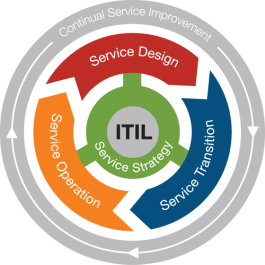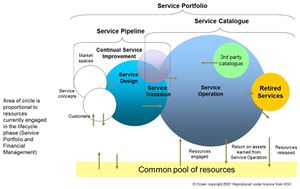Difference between revisions of "ITIL Service Lifecycle"
| Line 49: | Line 49: | ||
*Continual Improvement of Service | *Continual Improvement of Service | ||
**Seven Steps to the Improvement Process<ref>The Goals, Processess and Functions of the ITIL Service Lifecycle Stages [https://www.researchgate.net/figure/The-ITIL-service-lifecycle-6-The-processes-and-functions-proposed-by-the-ITILR-V3-2011_fig8_305953563/download Carolina Ferreira, Andrea Nery,Placido Rogerio Pinheiroa]</ref> | **Seven Steps to the Improvement Process<ref>The Goals, Processess and Functions of the ITIL Service Lifecycle Stages [https://www.researchgate.net/figure/The-ITIL-service-lifecycle-6-The-processes-and-functions-proposed-by-the-ITILR-V3-2011_fig8_305953563/download Carolina Ferreira, Andrea Nery,Placido Rogerio Pinheiroa]</ref> | ||
| + | |||
| + | When the Service Lifecycle concept was introduced to the ITIL framework some years ago, the IT Service Management community took a big step forward: ITIL Best Practice turned from a rather isolated process-driven view (ITIL V2) into a more holistic, service lifecycle-oriented approach (ITIL V3), something that didn’t fundamentally change in the 2011 edition. In a nutshell, it’s simple as that: IT services, delivering value to clients, pass through a lifecycle from service structuring, design, transition, operations (where the service is delivered to the client) and finally continual optimization. The role of ITSM processes is to support the Service Lifecycle. Just to give you a practical example: Change Management, which supports mainly the Service Transition Lifecycle, makes sure that Changes to Services are introduced into Operations in a controlled manner and with minimal risk. | ||
| + | |||
| + | '''The Service Portfolio is the “backbone” of the Service Lifecycle''' | ||
| + | |||
| + | [[File:Service_portfolio.jpg|300px|Service Portfolio]]<br /> | ||
| + | source: Blog.ITIL.Org | ||
| + | |||
| + | [[Service Portfolio Management]] and later on Service Catalogue Management are excellent methods to govern your services throughout the Service Lifecycle. The Service Portfolio ensures that you as an IT Service Provider Organization have the right mix of services to meet required business outcomes at an appropriate level of investment. Once these services are in the transition and service operation phase (visible to the client), they are maintained as part of the service catalogue, containing detailed service information. One really useful thing to remember is that whatever ITSM process you are discussing in your organization, you always can refer back to the service portfolio and catalogue to make sure, that you are still oriented towards the IT services that has to be delivered to your client. | ||
Revision as of 20:31, 5 January 2021
ITIL Service Lifecycle is a framework consisting of processes for effectively managing the service lifecycle of any product or service offered by an organization. Although it is an approach for IT Service Management (ITSM), it can be used by any organization irrespective of its size to manage the full lifecycle of not only the IT services but any service that it offers. Service lifecycle helps to improve the service management technique by using five processes to achieve better business performance.[1]
The ITIL version 3 proposes the concept of service life cycle containing stages, each with different goals, as follows:
- Service Strategy - SS: to understand the company's strategy and define how IT services will meet the strategic objectives of the organization;
- Service Design - SD: to guide the design of IT services to ensure service quality, customer satisfaction and the cost-benefit relationship of the services provided;
- Service Transition - ST: to guide the development of resources for the creation of new services or services in IT operations and ensure that they meet the business needs according to the "strategy" and "design" of the services;
- Service Operation - SO: to provide guidance on how to achieve effectiveness and efficiency in the delivery and support of services, to ensure the value expected by the customer and meet the strategic goals of the company;
- Continual Service Improvement - CSI: to identify results and advise on the improvement of services by joining forces with the Strategy, Design, Transition and Operation Services phases in order to create and maintain the value of services.
The processes and functions proposed by the ITIL® V3 2011 edition for each stage of the service lifecycle, as shown in figure above, are:
- Service Strategy
- Strategy Management Process for IT Services
- Financial Management Process for IT Services
- Service Portfolio Management Process
- Demand Management Process and
- Management of the Relationship with the Business Process
- Service Design
- Design Coordination Process
- Service Catalog Management Process
- Service Level Management Process
- Capacity Management Process
- Availability Management Process
- Management of IT
- Service Continuity Process
- Supplier Management Process
- Service Transition
- Planning and Transition Support Process
- Change Management Process
- Configuration and Service Asset Management Process
- Knowledge Management Process
- Release and Deployment Management Process
- Validation and Service Testing Process
- Changes Evaluation Process
- Service Operation
- Event Management Process
- Incident Management Process
- Request Fulfillment Process
- Access Management Process
- Problem Management Process
- Service Desk Function
- Technical Management Function
- IT Operations Management Function
- Application Management Function
- Continual Improvement of Service
- Seven Steps to the Improvement Process[2]
When the Service Lifecycle concept was introduced to the ITIL framework some years ago, the IT Service Management community took a big step forward: ITIL Best Practice turned from a rather isolated process-driven view (ITIL V2) into a more holistic, service lifecycle-oriented approach (ITIL V3), something that didn’t fundamentally change in the 2011 edition. In a nutshell, it’s simple as that: IT services, delivering value to clients, pass through a lifecycle from service structuring, design, transition, operations (where the service is delivered to the client) and finally continual optimization. The role of ITSM processes is to support the Service Lifecycle. Just to give you a practical example: Change Management, which supports mainly the Service Transition Lifecycle, makes sure that Changes to Services are introduced into Operations in a controlled manner and with minimal risk.
The Service Portfolio is the “backbone” of the Service Lifecycle
Service Portfolio Management and later on Service Catalogue Management are excellent methods to govern your services throughout the Service Lifecycle. The Service Portfolio ensures that you as an IT Service Provider Organization have the right mix of services to meet required business outcomes at an appropriate level of investment. Once these services are in the transition and service operation phase (visible to the client), they are maintained as part of the service catalogue, containing detailed service information. One really useful thing to remember is that whatever ITSM process you are discussing in your organization, you always can refer back to the service portfolio and catalogue to make sure, that you are still oriented towards the IT services that has to be delivered to your client.
- ↑ Definition - What Does ITIL service Library Mean? EduCBA
- ↑ The Goals, Processess and Functions of the ITIL Service Lifecycle Stages Carolina Ferreira, Andrea Nery,Placido Rogerio Pinheiroa


